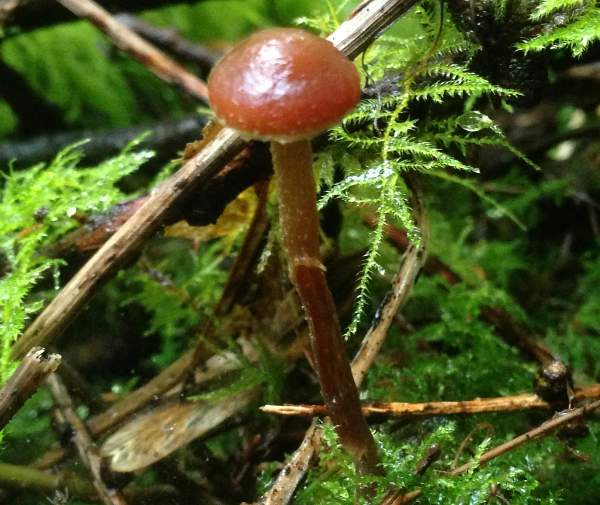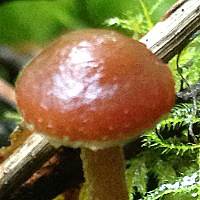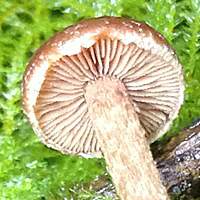Trees Birds Mammals Fish Amphibians Reptiles
Wild Algarve
Bookshop
Galerina paludosa (Fr.) Kühner - Bog Bell
Phylum: Basidiomycota - Class: Agaricomycetes - Order: Agaricales - Family: Strophariaceae
Distribution - Taxonomic History - Etymology - Toxicity - Identification - Reference Sources

Galerina paludosa with its reddish-brown caps, is a fairly common sight in upland bogs and on wet moorland; however, these are not the most hospitable of sites to visit on foot, and so a high proportion of the formal records for this species are from mossy areas of relatively-accessible woodlands.
Identifying with certainty the many small Galerina and Mycena mushrooms requires microscopic examination (preferably assisted by chemical testing!).
Distribution
Galerina paludosa is a fairly common sight in acidic moorland, mossy wet woodlands and Sphagnum-filled bogs in Britain and Ireland. This species is also recorded throughout most of mainland Europe and in North America.
Taxonomic history
This attractive little mushroom was described in 1838 by Elias Magnus Fries, who gave it the binomial scientific name Agaricus paludosus. (Most gilled fungi were initially dumped into a gigantic Agaricus genus, since largely redistributed across several newer genera.)
It was German mycologist Robert Kühner (1903 - 1996) who, in 1935, transferred this species to the genus Galerina, thus establishing its currently-accepted binomial name Galerina paludosa.
Synonyms of Galerina paludosa include Agaricus paludosus Fr.,Galera paludosa (Fr.) P. Kumm., Tubaria paludosa (Fr.) P. Karst., and Pholiota paludosa (Fr.) Pat.
Etymology
Galerina means 'like a helmet', while the specific epithet paludosa means 'of bogs or swamps' - an appropriate epithet for this little moorland/bog mushroom.
Toxicity
Galerina paludosa is described in many field guides as inedible or suspect. In view of the fact that other fungi in this genus are known to be toxic toadstools - for example Galerina marginata contains deadly poisonous amatoxins which are the same kinds of substances that make Amanita phalloides, the Death Cap, so dangerous - this species should not be collected for eating.
Identification guide
 |
Cap
Initially conical becoming convex then bell-shaped or slightly umbonate with an incurved margin, ochre brown to reddish brown; hygrophanous, darkest when young and moist, drying out greyish orange and palest at the margin; 8 to 25mm in diameter when fully expanded. |
 |
Gills
Moderately spaced, adnate, often with a small decurrent tooth; with 2 or three sizes of lamellulae.
Stem
1.5 to 3mm in diameter and 4 to 12cm
tall; cylindrical, paler than the cap; fibrous a covered in flaky scales; white, white partial veil forms a superior ring zone of fibrils and irregular patches of veil fibrils adhering to the stem below the ring zone. The stem base where it is attached to the moss is tomentose. |
| |
Basidia
Clavate, four-spored, with clamps.
Spores
Ellipsoidal, 9.5-11 x 6-7 μm; finely warty.
Spore print
Brown. |
Odour/taste |
Odour and taste not significant. |
Habitat & Ecological role |
On moors, in wet woodlands and in bogs, invariably with Sphagnum moss, upon which it is reported to be parasitic. |
Season |
May to October in Britain and Ireland. |
Similar species |
Kuehneromyces mutabilis, a much larger mushroom, is similar in colour range but has a pale cap centre and a darker margin; it does not grow in grass but is confined to mainly hardwood substrates. |
Reference Sources
, Pat O'Reilly (2016)
BMS List of English Names for Fungi
Redhead, S. A.. (1981). Parasitism of bryophytes by agarics. Can J Bot 59:63–67.
Dictionary of the Fungi; Paul M. Kirk, Paul F. Cannon, David W. Minter and J. A. Stalpers; CABI, 2008
Taxonomic history and synonym information on these pages is drawn from many sources but in particular from the British Mycological Society's GB Checklist of Fungi.
Acknowledgements
This page includes pictures kindly contributed by Simon Harding.
Top of page...
Fascinated by Fungi. Back by popular demand, Pat O'Reilly's best-selling 450-page hardback book is available now. The latest second edition was republished with a sparkling new cover design in September 2022 by Coch-y-Bonddu Books. Full details and copies are available from the publisher's online bookshop...